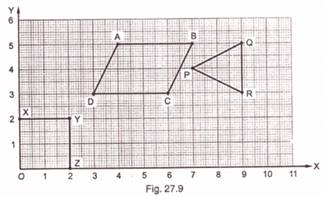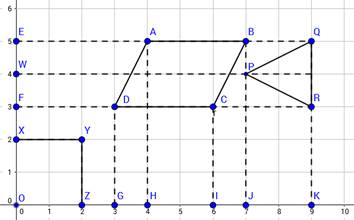Write the coordinates of each of the vertices of each polygon in Fig. 27.9.


In quadrilateral OXYZ,
O lies on the origin and the coordinates of the origin are (0, 0). So, the coordinates of O are (0, 0).
X lies on the y-axis. So, the x-coordinate is 0. Hence, the coordinate of X is (0, 2).
Also, YX is equal to 2 cm and YZ is equal to 2 cm. So, the coordinates of vertex Y are (2, 2).
Z lies on the x-axis. So, the y-coordinate is 0. Hence, the coordinates of Z are (2, 0).
In polygon ABCD,
Draw perpendiculars DG, AH, CI and BJ from A, B, C and D on the x-axis and DF, AE, CF and BE from A, B, C and D on the y-axis.
DF = 3 cm and DG = 3 cm
Therefore, the coordinates of D are (3, 3).
AE = 4 cm and AH = 5 cm
Therefore, the coordinates of A are (4, 5).
CF = 6 cm and CI = 3 cm
Therefore, the coordinates of C are (6, 3).
BE = 7 cm and BJ = 5 cm
Therefore, the coordinates of B are (7, 5).
In triangle PQR,
Draw perpendiculars PJ, QK and RK from P, Q and R on the x-axis and PW, QE and RF from P, Q and R on the y-axis.
PW = 7 cm and PJ = 4 cm
Therefore, the coordinates of P are (7, 4).
QE = 9 cm and QK = 5 cm
Therefore, the coordinates of Q are (9, 5).
RF = 9 cm and RK = 3 cm
Therefore, the coordinates of R are (9, 3).